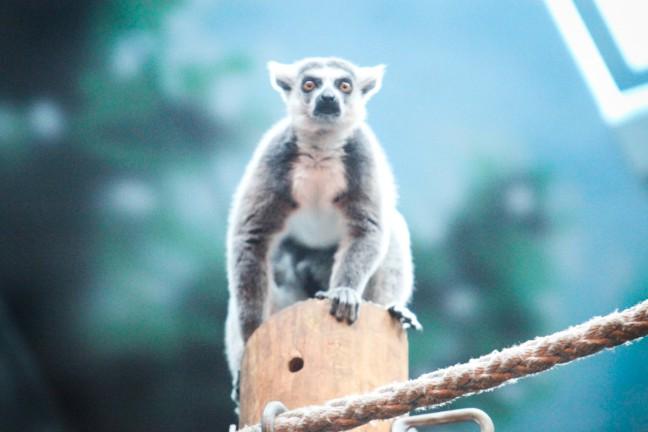Upon entering Henry Vilas Zoo, located just south of Madison on Lake Wingra, one would be pleasantly surprised to learn it’s free to enter the facility. But this is also a warning sign the zoo isn’t properly supporting its animals.
I was full of childlike excitement when I first went to Henry Vilas. My grandmother used to work as a guide for a large zoo and as a child I looked forward to tagging along with her.
There, the zoo staff was extensive and each member unconditionally loved the animals they cared for. Many of the exotic creatures were in captivity due to illness or endangerment and they seemed to thrive in their new environment.
With these expectations in mind, one can imagine the horror I felt finding a giraffe entrapped in a two-stalled barn structure and tigers pacing back and forth in a cramped enclosure. In the time I spent at Henry Vilas, I didn’t cross paths with a single zookeeper.
I knew Madison itself was home to plenty of talented veterinarians, animal scientists and caretakers. Where were they?
I left the Zoo with a strange sense of guilt — and frankly, nausea. If the Zoo was suffering so significantly from lack of funding, why could I walk freely through its exhibitions?
From disturbingly small animal enclosures to a low number of staff visible throughout the park, it is obvious significant changes need to be made to the Henry Vilas Zoo to bring it up to a modern, ethical standard.
In 2019, Dane County ended its partnership with the Henry Vilas Zoological Society, a non-profit that fundraised for the zoo. The county asserts there were many unresolvable issues with HVZS, one being the Society hadn’t been fully transparent with how funds were managed and distributed.
Many staff members at the Zoo expressed sadness at the decision to end the county partnership, but given the state of the Zoo, I am not opposed to the County’s decisions. Ending this unsuccessful partnership with the Zoological Society was a crucial step in protecting the integrity of the facility those zoo workers hold so dear.
But at the same time as this drop in funding, Dane County released documents showing concerns from the Association of Zoos and Aquariums over animal welfare at the zoo. The association found animals spent too much time in small areas and received insufficient veterinary care.
Zoos across the world are facing heightened criticism over the ethics of keeping non-domestic animals in captivity for human entertainment. Many wildlife experts argue animal enclosures focused on entertainment should be phased out in the next 25 years.
Henry Vilas Zoo was founded in 1904 “for the uses and purposes of a public park and pleasure ground.” It also prides itself on being one of ten zoos in the U.S. that remains free to the public. But without significant emphasis on conservation and animal care, Henry Vilas shouldn’t be bragging about this.
I don’t want zoos to be eradicated completely.
Many of them are partnered with research institutions focusing on rehabilitation, conservation and education — particularly for saving species that would otherwise go extinct in the wild.
Science broadcaster David Attenborough recognizes the value of animal captivity for conservation reasons. In an interview with The Guardian, he argues that without zoos and aquariums, many animal species wouldn’t exist.
“Breeding programmes for animals that are on the verge of extinction are of incredible importance,” Attenborough said. “If it was not for zoos, there would be no Arabian oryx left in the world, for example.”
Mote Marine Aquarium in Sarasota, Florida is one example of a facility that holds itself to a mission of protecting marine life and educating the public on how to join this effort. Unlike Henry Vilas, Mote charges an entrance fee and has a very public program to raise money for its efforts.
Very few modern zoos have continued to pursue a mission of conservation and those that do rely on a huge amount of funding. As suggested in The New York Times, these higher funded zoos rehabilitate and reintroduce animals as much as they showcase the animals in exhibits.
A common philosophy about zoos is that by displaying exotic creatures, people become empathetic and attached to the creatures and then vote in favor of policies that protect them. That’s all valid, but if proper attention is not provided to the animals actually on display, it becomes an empty attempt to justify ownership over exotic creatures.
Many of us COVID-era college students are familiar with the “Tiger King” series after having binged it with our families back home. The Netflix docuseries depicts how animal cruelty can exist right under our noses, leading many people to donate time and money to efforts fighting such forms of animal entertainment.
This same attention to the wellbeing of exotic creatures can be applied in Madison.
If citizens want to continue enjoying Henry Vilas, more action needs to be taken to increase funding at the zoo. It should also adopt a new conservation mission or partner with UW environmental departments to shift its purpose from entertainment to research.
If zoos are to remain an educational and entertaining pastime for families, school groups and animal lovers, they must be held accountable for oversight and inaction. Until Henry Vilas Zoo can commit to a mission based wholly on conservation, people should disregard its wholesome reputation.


